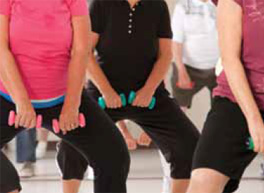
When you hear the term “eccentric,” you may think of a quirky aunt or a piece of shabby but chic furniture. In the physical therapy world, however, this term has a much different and very important meaning. Eccentric exercise—active contraction of a muscle while it is lengthening—has gained popularity in recent years among both athletes and the therapeutic community.
To understand the difference between concentric and eccentric exercise, think of it this way: When you lift a weight, your muscle contracts and shortens—this is called concentric movement. But when you lower the weight, those same muscle fibers lengthen while still bearing the weight, creating eccentric movement.
Although new machines promising a better eccentric training experience constantly appear on the market, there are plenty of simple ways to incorporate eccentric movements into your therapeutic routine. For example, doing a slow squat and then rising will work your quad muscles eccentrically; slowly lowering a hand weight is also a good eccentric exercise. Even something as low-tech as walking down a hill is great eccentric training.
Studies conducted over the last decade have suggested that eccentric training can be especially helpful in treating the elderly and people recovering from surgical repairs, as well as those with degenerative disorders of the central nervous system and tendon injuries. One study even found that a 12-week eccentric rehabilitation intervention was just as effective as surgery for people suffering from patellar tendinopathy (jumper’s knee), a common injury in athletes.
The great thing about utilizing eccentric exercise as part of your physical therapy is that it not only strengthens muscles but also improves their function. In fact, eccentric training uses less energy while building more muscle than concentric exercises.
So, whether you are a professional athlete or someone struggling through basic functions, such as sitting or climbing (or in this case, descending) a flight of stairs, the benefits of eccentric exercise are clear. We can design an individualized program of eccentric exercises that will help you recover from surgery or get through your daily activities stronger and free of pain.
